| Revision as of 04:29, 12 August 2015 editNareshrana01 (talk | contribs)85 editsNo edit summaryTags: Visual edit Mobile edit Mobile web edit← Previous edit | Revision as of 20:54, 13 August 2015 edit undoDeependra24dg (talk | contribs)210 edits →ReferencesNext edit → | ||
| Line 159: | Line 159: | ||
| ==References== | ==References== | ||
| {{Gwalior Metropolitan Region}} | |||
| ] | |||
| {{reflist|30em}} | {{reflist|30em}} | ||
Revision as of 20:54, 13 August 2015
| Gwalior Fort | |
|---|---|
| Part of Madhya Pradesh | |
| Madhya Pradesh, India | |
 Man Mandir Man Mandir | |
 | |
| Type | Fort |
| Site information | |
| Controlled by | Government of Madhya Pradesh |
| Open to the public | Yes |
| Condition | Good |
| Site history | |
| Built | 8th century and 14th century |
| Built by | Hindu Kings of India |
| In use | Yes |
| Materials | Sandstones and lime mortar |
Gwalior Fort (Template:Lang-hi Gwalior Qila) is an 8th-century hill fort near Gwalior, Madhya Pradesh, central India. The fort consists of a defensive structure and two main palaces, Gurjari Mahal and Man Mandir, built by Man Singh Tomar. The fort has been controlled by a number of different rulers in its history. The Gurjari Mahal palace was built for Queen Mrignayani. It is now an archaeological museum.
Etymology

The word Gwalior is derived from one of the Hindu words for saint, Gwalipa.
Topography

The fort is built on an outcrop of Vindhyan sandstone on a solitary rocky hill called Gopachal. This feature is long, thin, and steep. The geology of the Gwalior range rock formations is ochre coloured sandstone covered with basalt. There is a horizontal stratum, 342 feet (104 m) at its highest point (length 1.5 miles (2.4 km) and average width 1,000 yards (910 m)). The stratum forms a near-perpendicular precipice. A small river, the Swarnrekha, flows close to the palace.
Rulers

Legend tells that Suraj Sen Kachwaha, chieftain of the nearby Silhonia village was on a hunting trip. He came upon the hermit, Gwalipa (Galava) who gave the chieftain healing water from the Surajkund reservoir. In gratitude for the healing of leprosy, the chieftain founded Gwalior, naming it after Gwalipa. The earliest record of the fort is 525 AD where it is mentioned in an inscription in the temple of the Hun) emperor, Mihirakula (510 AD). Near the fort is an 875 AD Chaturbhuj temple associated with Telika Mandir.
Pal dynasty of Kachawaha
The Pal dynasty of 86 kings ruled for 989 years. It began with Suraj Pal and concluded with Budha Pal. Budha Pal's son was Tej Karan (1127 - 1128). Gwalipa prophesied that the Pal dynasty would continue while the patronym, Pal was kept. Tej Keran married the daughter of Ran Mul, ruler of Amber (Jaipur) and received a valuable dowry. Tej Keran was offered the reign of Amber as long as he made it his residence. He did so, leaving Gwalior under Ram Deva Pratihar.
Gurjara-Pratihara Dynasty
The Gurjara-Pratihara dynasty at Gwalior included Pramal Dev, Salam Dev, Bikram Dev, Ratan Dev, Shobhang Dev, Narsinh Dev and Pramal Dev.
Turkic conquest
In 1023 AD, Mahmud of Ghazni unsuccessfully attacked the fort. In 1196 AD, after a long siege, Qutubuddin Aibak, first Turkic sultan of Delhi took the fort, ruling till 1211 AD. In 1231 AD, the fort taken by Iltumish, Turkic sultan of Delhi. Under attack from Timurlane, Narasingh Rao, a Jaina chieftain captured the fort.
Tomar rulers
The Rajput Tomara clan ruled Gwalior from 1398 (when Pramal Dev captured the fort from a Muslim ruler) to 1518 (when Vikramaditya was defeated by Ibrahim Lodhi).

- Pramal Dev (Ver Singh, Bir Sing Deo) 1375.
- Uddhharan Dev (brother of Pramal Dev).
- Lakshman Dev Tomar
- Viramdev 1400 (son of Virsingh Dev).
- Ganapati Dev Tomar 1419.
- Dugarendra (Dungar) Singh 1424.
- Kirti Singh Tomar 1454.
- Mangal Dev (younger son of Kirti Singh).
- Kalyanmalla Tomar 1479.
- Man Singh Tomar 1486 - 1516 (builder of the Man mandir).
- Vikramaditya Tomar 1516.
- Ramshah Tomar 1526.
- Salivahan Tomar 1576.
Suri dynasty
In 1519, Ibrahim Lodi took the fort. After his death, control passed to the Mughal emperor Babur. Babur's son, Humayun, was defeated by Sher Shah Suri. After Suri's death in 1540, his son, Islam Shah, moved power from Delhi to Gwalior for strategic reasons. After the death of Islam Shah in 1553, his incumbent, Adil Shah Suri, appointed the Hindu warrior, Hemu, as manager of Gwalior. From 1553 - 1556, Hemu attacked Adil Shah Suri and others from the fort.
Mughal dynasty
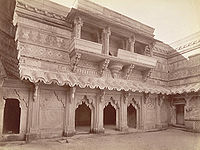
When the Mughal leader, Akbar captured the fort, he made it a prison for political prisoners. For example, Kamran, Akbar's cousin was held and executed at the fort. Aurangzeb's brother, Murad and nephews Suleman and Sepher Shikoh were also executed at the fort. The killings took place in the Man Madir palace.
Rana Raizada dynasty

The Raizada Rajputs of Junagarh occupied the fort on three occasions between 1740 and 1783. (Maharaja Bhim Singh Rana 1740 - 1756; Maharaja Chhatra Singh Rana 1761 - 1767; and Maharaja Chhatra Singh Rana 1780 - 1783).
Maratha rule

In 1779, the Scindia clan of the Maratha Empire stationed a garrison at the fort. The fort was contested in the First Anglo-Maratha War. On August 3, 1780, the East India Company under Captains Popham and Bruce captured the fort in a daring nighttime raid, scaling the walls with 12 grenadiers and 30 sepoys. Both sides suffered fewer than 20 wounded total. In 1784, the Marathas under Mahadji Sinde, recovered the fort. There were frequent changes in the control of the fort between the Scindias and the British between 1808 and 1844. In January 1844, after the battle of Maharajpur, the fort was occupied by the Marathas as protectorate of the British government.
Rebellion of 1857
On 1 June 1858, Rani Lakshmi Bai led a rebellion. The Central India Field Force, under General Hugh Rose, besieged the fort. Bai died on 18 June 1858.
Structures

The fort and its premises are well maintained and house many historic monuments including palaces, temples and water tanks. There are eleven temples to Gautama Buddha and the tirthankaras of Jainism. There are also a number of palaces (mahal) including the Man mandir, the Gujari, the Jahangir, the Karan, and the Shah Jahan. The fort covers an area of 3 square kilometres (1.2 sq mi) and rises 35 feet (11 m). Its rampart is built around the edge of the hill, connected by six bastions or towers. The profile of the fort has an irregular appearance due to the undulating ground beneath. On the southern side are 21 temples cut into the rock with intricately carved tirthankaras. One, Pārśva, the 23rd local saint, is 40 feet (12 m) high.
There are two gates; one on the northeast side with a long access ramp and the other on the southwest. The main entrance is the ornate Elephant gate (Hathi Pul). The other is the Badalgarh Gate. The Man Mandir palace or citadel is located at the northeast end of the fort. It was built in the 1400s and refurbished in 1648. The water tanks or reservoirs of the fort could provide water to a 15,000 strong garrison, the number required to secure the fort.
Man mandir palace
The Man mandir palace was built by the King of Tomar Dynasty - Maharaja Man Singh.
Hathi Pol


The Hathi Pol gate (or Hathiya Paur), located on the southeast, leads to the Man mandir palace. It is the last of a series of seven gates. It is named for a life-sized statue of an elephant (hathi) that once adorned the gate. The gate was built in stone with cylindrical towers crowned with cupola domes. Carved parapets link the domes.
Gujari Mahal museum
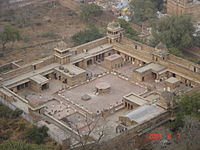
Gujari Mahal was built by Raja Man Singh for his wife Mrignayani, a Gujar princess. She demanded a separate palace for herself with a regular water supply through an aqueduct from the nearby Rai River. The palace has been converted into an archaeological museum. Rare artefacts at the museum include Hindu and Jain sculptures dated to the 1st and 2nd centuries BC; miniature statue of Salabhanjika; Terracotta items and replicas of frescoes seen in the Bagh Caves.
Teli ka mandir
The Teli-ka mandir (the oilman’s temple or oil pressers' temple) is a Brahmanical sanctuary built in the 8th (or perhaps the 11th century) and was refurbished between 1881 and 1883. It is the oldest part of the fort and has a blend of south and north Indian architectural styles. Within the rectangular structure is a shrine with no pillared pavilions (mandapa) and a Buddhist barrel-vaulted roof on a Hindu mandir. Buddhist architectural elements are found in the Chitya type hall and torana decorations at the entrance. There is a masonry tower in the nagari architectural style with a barrel vaulted roof 25 metres (82 ft) in height. The niches in the outer walls once housed statues but now have gavakshas (horse shoe arch) ventilator openings in the north Indian style. The gavaksha has been compared to the trefoil, a honeycomb design with a series of receding pointed arches within an arch. The entrance door has a torana or archway with sculpted images of river goddesses, romantic couples, foliation decoration and a Garuda. Diamond and lotus designs are seen on the horizontal band at the top of the arch indicating an influence from the Buddhist period. The vertical bands on either side of the door are decorated in a simple fashion with figures that are now badly damaged. Above the door are a small grouping of discs representing the finial (damalaka) of an Indo-Aryan Shikhara. The temple was originally dedicated to Vishnu, but later converted to the worship of Siva.
Garuda monument
Close to the Teli ka Mandir temple is the Garuda monument, dedicated to Vishnu, is the highest in the fort. It has a mixture of Muslim and Indian architecture. The word Teli comes from the Hindu word Taali a bell used in worship.
Saas-bahu temple
In 1093, the Pal Kachawaha rulers built two temples to Vishnu. The temples are pyramidal in shape, built of red sandstone with several stories of beams and pillars but no arches.
Karn mahal
The Karn mahal is another significant monument at Gwalior Fort. The Karn mahal was built by the second king of the Tomar dynasty, Kirti Singh. He was also known as Karn Singh, hence the name of the palace.
Vikram mahal
The Vikram mahal (also known as the Vikram mandir, as it once hosted a temple of Shiva) was built by Vikramaditya Singh, the elder son of Maharaja Mansingh.He was a devotee of Shiva. The temple was destroyed during Mughal period but now has been re-established in the front open space of the Vikram mahal.
Chhatri of Bhim Singh Rana
This chhatri (cupola or domed shaped pavilion) was built as a memorial to Bhim Singh Rana (1707-1756), a ruler of Gohad state. It was built by his successor, Chhatra Singh. Bhim Singh occupied Gwalior fort in 1740 when the Mughal Satrap, Ali Khan, surrendered. In 1754, Bhim Singh built a bhimtal (a lake) as a monument at the fort. Chhatra Singh built the memorial chhatri near the bhimtal. Every year, the Jat Samaj Kalyan council (parishad) of Gwalior organises a fair on Rama Navami, in honor of Bhim Singh Rana.
Other monuments
There are several other monuments built inside the fort area. These include the Scindia School (an exclusive school for the sons of Indian princes and nobles)that was founded by Madho Rao Scindia in 1897, and the Gurdwara Data Bandi, a memorial to the sixth Sikh, Guru Hargobind.
Gallery
-
 Water reservoir.
Water reservoir.
-
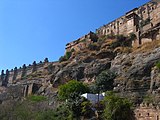 External view.
External view.
-
 Panoramic view.
Panoramic view.
-
 Fortress wall.
Fortress wall.
-
 One of the seven entry gates.
One of the seven entry gates.
-
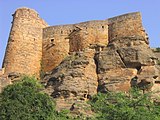 The fort bastions.
The fort bastions.
-
 The north room, Man Mandir.
The north room, Man Mandir.
-
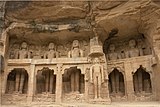 Jain tirthankaras.
Jain tirthankaras.
-
Rock cut Tirthankara statues.
-
Gujari Mahal.
-
Entrance.
-
 Chhatri near Bhimtal in memory of Maharaja Bhim Singh Rana
Chhatri near Bhimtal in memory of Maharaja Bhim Singh Rana
-
 Sas-Bahu temple.
Sas-Bahu temple.
-
 Small temple.
Small temple.
-
 Sculptures.
Sculptures.
-
 Gate of Teki Mandir.
Gate of Teki Mandir.
-
 Teli-ka-Mandir.
Teli-ka-Mandir.
-
Mythological statue.
References
Template:Gwalior Metropolitan Region
- Fodor E. et al "Fodor's India." D. McKay 1971. p293. Accessed at Google Books 30 November 2013.]
- Oldham R. D. "A manual of the geology of India." 1108072542, 9781108072540 Cambridge University Press 2011. p65 Accessed at Google Books 30 November 2013.
- Mitra S. (Ed.) "Orchha, travel guide." Goodearth publications 2009. p65. Accessed at Google Books, 30 November 2013.
- Bhayasaheb B. R. (translator) "History of the Fortress of Gwalior." Education Society's Steam Press, Byculla, 1892. University of Michigan. p432. Accessed at Google Books 30 November 2013.
- Bakshi S. R. "Early Aryans to Swaraj." Sarup & Sons, 2005. p321 ISBN 8176255378, 9788176255370. Accessed at Google Books 30 November 2013.
- ^ Torton E. "A gazetteer of the territories under the government of the East-India company, and of the native states on the continent of India, Volume 2" W. H. Allen & Co. 1854.
- ^ Singh N. "Jat-Itihas." 2004.
- Tyagi V. P. "Martial races of undivided India." Gyan Publishing House, 2009 ISBN 8178357755, 9788178357751. p75. Accessed at Google Books 1 December 2013.
- Malleson G. B. "An Historical Sketch of the Native States of India." The Academic Press, Gurgaon, 1984 (reprint).
- Krishnan V. N. "Madhya Pradesh District Gazetteer." Gwalior.
- Agnihotri A. K. "Gohad ke jaton ka Itihas." Nav Sahitya Bhawan. New Delhi, Delhi. 1985. p. 29.
- Cite error: The named reference
India Gazettewas invoked but never defined (see the help page). - "Temples of Gwalior" Kamat's Potpourri Webpage. Accessed 1 December 2013.
- Allen M. P. "Ornament in Indian architecture." University of Delaware Press 1991. ISBN 0-87413-399-8.
Further reading
- Tillotson G. H. R. "The Rajput Palaces – The Development of an Architectural Style" Yale University Press. New Haven and London 1987. First edition. Hardback. ISBN0-300-03738-4
External links
 Gwalior Fort travel guide from Wikivoyage
Gwalior Fort travel guide from Wikivoyage
- Use dmy dates from September 2013
- Metropolitan Areas
- Buildings and structures completed in the 8th century
- Rajput architecture
- Forts in Madhya Pradesh
- Buildings and structures in Gwalior
- History of Gwalior
- Indian rock-cut architecture
- Jain Rock-cut architecture
- Buildings and monuments on Indian postage stamps